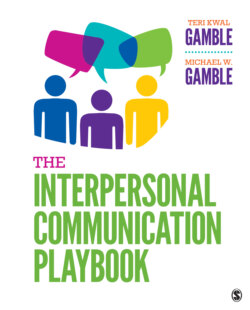Читать книгу The Interpersonal Communication Playbook - Teri Kwal Gamble - Страница 28
На сайте Литреса книга снята с продажи.
Visualizing Communication
ОглавлениеTo be sure, the thinking about interpersonal communication has evolved over the years. The earliest model—a linear or unidirectional model—depicted communication as going in one direction only. Questions such as “Did you get my message?” statements such as “I gave you that idea,” and acts such as leaving someone a note with instructions suggest this one-way perspective.
Gradually, a more realistic two-way model—known as an interaction model—came to be preferred. The interaction model visualized interpersonal communication as a back-and-forth process, much like a game of tennis; it also acknowledges the presence and effects of both feedback and context. However, though more accurate than the one-way model, the interaction model fails to capture the complexity of interpersonal communication, including the reality that interpersonal communication does not involve a straightforward back-and-forth action and reaction as might occur when you send a text and a friend responds.
In reality, however, communication exchanges involve source and receiver responding to one another simultaneously rather than sequentially. A new and even more realistic transactional model, as shown in Figure 1.2, emerged to capture this reality. The transactional model’s strength is that it depicts sending and receiving as simultaneous rather than distinctly separate acts. In so doing, it helps us visualize the vital complexity of interpersonal interaction. (See Table 1.3 for a summary of the various models’ strengths and weaknesses.)
Description
Figure 1.2 Transactional Model of Interpersonal Communication
Noel Hendrickson/Photodisc/Thinkstock; Jupiterimages/Photos.com/Thinkstock
Table 1.3
Try This: Making Model Sense
Use the transactional model of interpersonal communication in Figure 1.2 to analyze the following dyadic scenario. Identify how each of the essentials of interpersonal communication included in the model—people, messages, channels, noise, feedback, context, and effect—makes its presence felt during the interaction.
Simona: (approaching a restaurant table): Hi, Kevin. I thought I recognized the back of your head. How ya doing? Long time no see.
Kevin: (turning, somewhat startled): I recognized your perfume—I used to love it when—(abrupt break). It’s been a while, hasn’t it? When was the last time we got together? Is it a year?
Simona: (smiling): Longer than that. I haven’t heard from or seen you since your divorce from Jan.
Kevin: Haven’t seen me since the divorce. That makes it almost 2 years and 24 days, then.
Simona: Time sure goes fast when you’re having fun, doesn’t it? Well, you look great. Life’s been good to you, huh?
Kevin: Yeah, I just got back from 6 months troubleshooting in Singapore. I got a promotion, and I’m finally making the kind of money I deserve.
Simona: Good for you! Emilio and I still see Jan, you know.
Kevin: Do you? How’s she doing? I haven’t spoken to her in 2 years, either.
Simona: You haven’t spoken to your ex since the divorce? Actually, I’m meeting her for lunch today.
Kevin: Didn’t seem to be anything left to say to her. (Does a double take) Did you say you’re meeting Jan here? I was just leaving. I’ve got to get back to the office. I’ve got a key client coming. It was sure nice running into you.
Simona: Sure thing. I’ll tell Jan you say hi.
Kevin: No. Don’t even tell her you saw me. It would just open up her old wounds.
Simona: Why would it do that? She’s great, has a great job, and she’s seeing one of Emilio’s friends. Besides, I’m sure she’d like to know you’re doing so well.
Kevin: So, she picked up the pieces, did she? I didn’t think it would happen that fast. She was so broken up, so devastated by my leaving.
Simona: Life goes on.
Kevin: Guess it does. Well, gotta go. Be good.
Simona: (Under her breath, as he walks away): What a conceited jerk!
